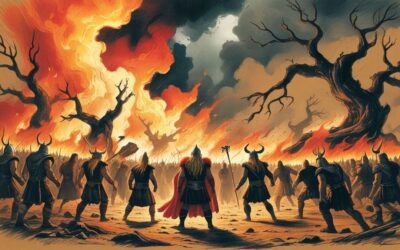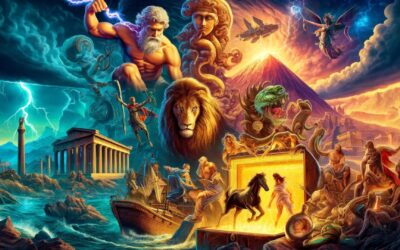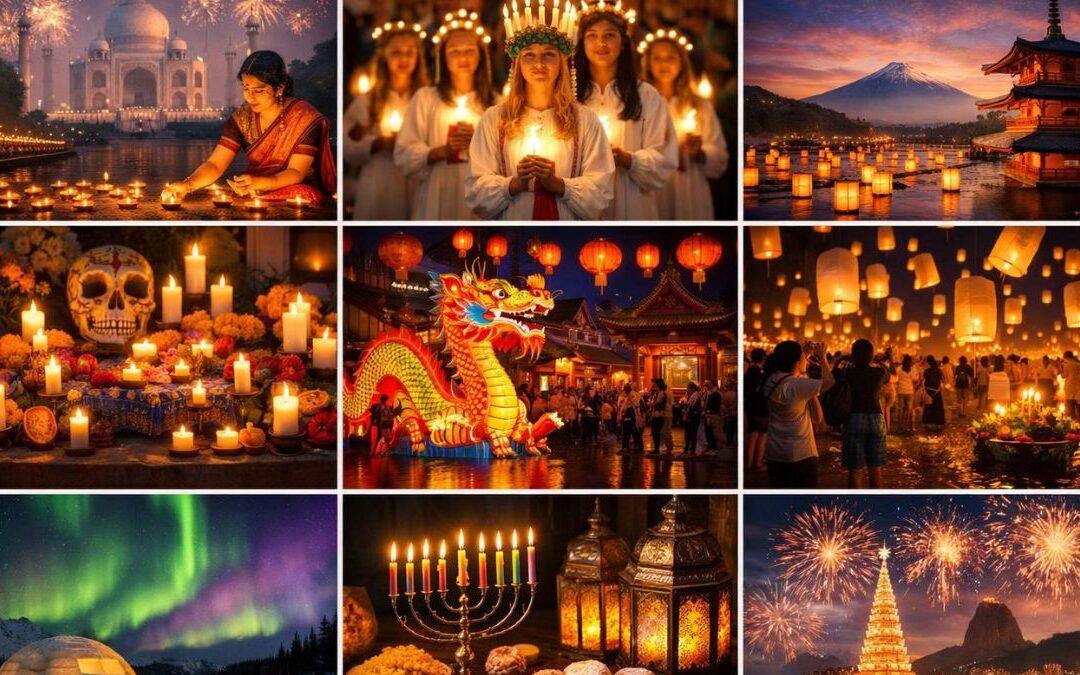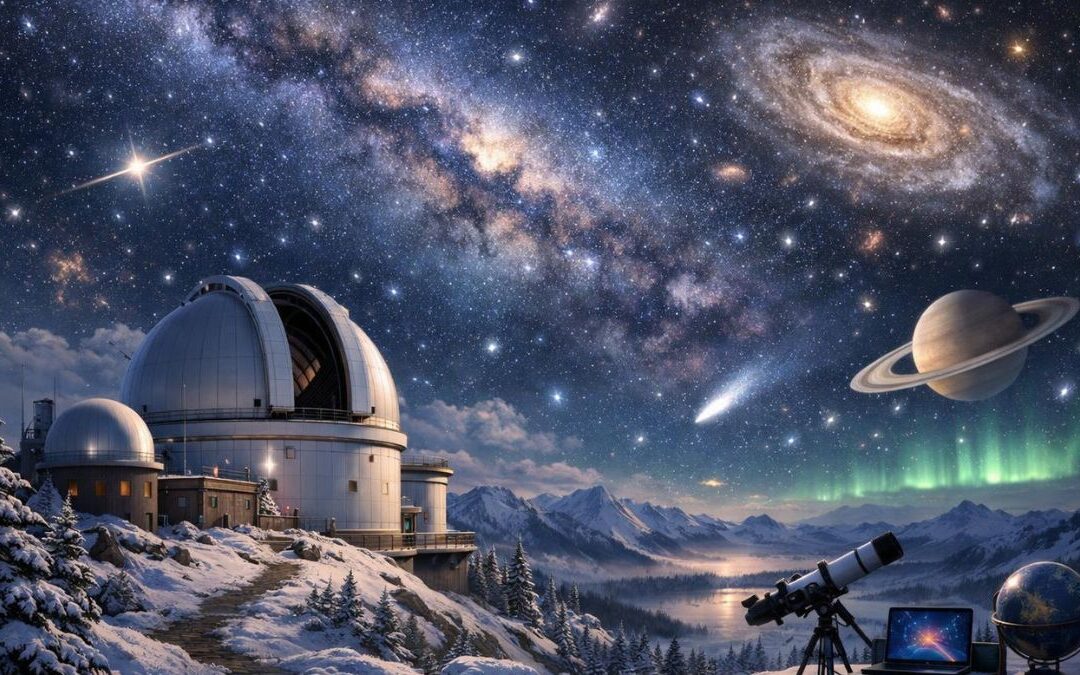Transcript
Disclaimer
I am using an automatic transcript service as it is not possible for me to do it on my own and I cannot afford human transcription at the moment. The service claims to have about 95% accuracy, which means there will still be some mistakes, so my apologies for having a less than perfect transcript, but I hope I can afford human transcription soon and I will solve this problem. However, the service is pretty good, and the transcript is almost perfect.
Transcript
Welcome to a new episode from English plus podcast. Today’s episode is about mythology, myths and legends. And we will talk specifically about Chinese mythology. We will talk about Chinese mythology in context. We will talk about the major deities and characters. We will talk about the key themes and in Chinese mythology.
[00:00:29] And finally, we will talk about Chinese mythology in art literature and everyday life. So without further ado, let’s start talking about Chinese mythology in this new myths and legends episode from English plus podcast. The people of China have a rich and complicated mythology that dates back nearly 4,000 years throughout Chinese history, myth and reality have been intertwined.
[00:00:57] Historical figures have been worshiped as gods and ancient myths are sometimes treated as historical truths. In addition three, great religious traditions, Confucianism Taoism, and Buddhism have played a role in shaping the mythology. The result is a rich tapestry of characters and tails, both real and imagined.
[00:01:20] And the unique Pantheon, a collection of recognized gods and goddesses organized very much like ancient Chinese society. China can trace its historical roots in an unbroken line for more than 4,000 years. And its mythological roots extend even farther back in time. From about 2000 to 1500 BCE, a people known as the Zia dominated the Northern regions of China, the ZR worship, the snake, a creature that appears in some of the oldest Chinese myths.
[00:01:53] Eventually the snake change into the dragon, which became one of the most enduring symbols of Chinese culture and mythology. From about 1500 to 10 66, BC E China was ruled by the Shang dynasty. The people at this time, worship many deities, including natural forces and elements such as rain, clouds, rivers, mountains, the sun, the moon, and the earth.
[00:02:20] Their greatest deity Shang D remains an important God in the Chinese Pantheon. When a new dynasty, the Zau came to power in China in 10 66, BCE significant changes took places in religion. People still worship the old gods, but ancestor worship became increasingly important. Confucianism anti-racism appeared near the end of the Zelle dynasty.
[00:02:46] These two religious traditions had an enormous influence on the development of the most basic and lasting principles of Chinese culture. In 213 BCE, many of the original sources of the Chinese mythology were lost when emperor she won the, of the chin dynasty, ordered the burning of all books on subjects, other than medicine, prophecy, and farming.
[00:03:11] This order was reversed in one 91, BCE and much of the literature was reconstructed, but works were written to support ideas popular with the Royal court at the time. These changes affected religious beliefs, producing a Pantheon of deities that mirrored the political organization of the Chinese empire.
[00:03:32] Gods and spirits had different strengths and areas of responsibility, just like Chinese officials shortly before 100 CE Buddhism arrived in China from India and added another important influence. The Chinese culture and mythology Buddhist ideas gradually came to be merged with Taoism and Confucianism in the minds of many Chinese.
[00:03:55] The three traditions often were seen as different aspects of the same religion and as having basically the same gods Buddhists and Taoists honoring each other’s deities in their temples and both incorporated principles of Confucianism, such as ancestor worship in their beliefs. Now let’s talk about the core deities and characters in Chinese mythology.
[00:04:19] The deities and characters that make up the body of Chinese mythology originate in many different regions and from several unique belief systems. For this reason, Chinese mythology is less uniform and consistent in its legends. Then the mythologies of many other cultures, but offers a wide range of tails and mythological figures to appreciate.
[00:04:42] Ben goo was the first living creature and the creator of the world among his act of creation, where the separation of the earth and sky, the placement of the stars and planets in the heavens and the shaping of the earth surface. It is often said that his body became the world on which all things live.
[00:05:03] For the Han people of ancient China, the Supreme God was known as Shang D in later times, this same deity came to be known as Tiana also used as a word for heaven or sky. There are few details about Chung D in Chinese mythology. Other than that, he was male and his duties involved rewarding. Those who were deserving and punishing those who were not Chung D was not represented in art.
[00:05:31] A similar deity is the Jade emperor also known as you want revert by towers as the Supreme ruler of heaven. According to legend, when you want was born as a Prince, the kingdom where he lived was flooded with light. As he grew, he showed a remarkable respect for all living things and devoted himself to helping the least fortunate members of the kingdom.
[00:05:56] After his father died, he ruled the region with greatness and eventually became immortal. According to myth, it took you Huang millions of years to achieve the status of Jade emperor, which was bestowed upon him by a group of deities. Two groups of characters central to Chinese mythology are the three sovereigns and the five emperors.
[00:06:19] All of these figures were believed to rule ancient regions of China, and many are credited with uplifting humans, to a state of advanced civilization through their leadership or their teachings. The three sovereigns are figures of the most ancient times. Two of the three Fuji and Noah were DDS who helped humankind continue in the aftermath of a great flood Fuji and new our brother and sister.
[00:06:45] And we’re the only two to survive the flood. They prayed to the Jade emperor who gave them permission to become a couple and repopulate the land in many versions of their tail. They also teach humans essential skills, such as hunting, fishing with nets and cooking food. The third of the three sovereigns Shennong is said to have taught people, the arts of agriculture and medicinal herbs, according to legend, Shannon went to the trouble of tasting hundreds of plants and minerals in an effort to determine which could be helpful to humans and which could be harmful or even poisonous.
[00:07:24] The five emperors are believed to be based on historical leaders who brought great advancements to their people. None were emperors in the traditional later use of the term. Rather they were tribal leaders who may have, so Ben elected to be in charge of a larger group of tribes. The first of the five emperors was the yellow emperor, also known as one D the yellow emperor was said to be the first Institute laws among the tribes he ruled.
[00:07:53] And he also brought the first music and art to his people. He became immortal and eventually power pass to his grandson is one zoo. Swung zoo made his own contributions to Chinese culture, expanding his kingdom and unifying religions and marriage practices for all his subjects. The kingdom was later ruled by his son CU and by cous Sanjo, it is believed that Kool ruled for 70 years while his son Yow ruled for over 100 years.
[00:08:25] Yeah. According to tradition invented the Chinese board game goal, which was considered an essential way to learn strategy and planning. The last of the five emperors was shunned son-in-law to Yahoo and ruler for nearly 50 years. He was originally a simple farmer, but his humility and dedication to religion won him a reputation that spread all the way to y’all’s throne.
[00:08:50] Since y’all was dissatisfied with his own son’s behavior. He allowed Sean to marry two of his daughters and become the next in line to rule. Yeah. And Sean are often viewed together as the perfect leaders whose behavior Rose above any possible hint of misdeed and whose popularity has been unmatched since.
[00:09:11] Other important figures from Chinese history have developed their own unique legends that expand upon their true historical accomplishments. Two of the most important of these figures are the religious and philosophical leaders, Confucius and lousy born in five 51 BCE to a poor family of aristocratic background.
[00:09:31] Confucius began a teaching career after working as a minor government official. For Confucius, the goal of education and learning was self knowledge and self-improvement, which would lead one to write conduct. Although his method of education was aimed at ensuring the smooth operation of a stable and well-ordered state.
[00:09:52] His teachings became a guide to living wisely as well. Confucius attracted many followers who spread his ideas after his death in four 79 BCE. A number of legends grew up about Confucius, including one in which dragons guarded his mother. When he was born. According to another story, a unicorn appeared at his birth and spit out a piece of Jade with a prophecy written on it saying that the infant would become an uncrowned emperor.
[00:10:21] Considering the immense impact of Confucius on Chinese culture. The prophecy came through. Taoism also known as Daoism arose about the same time as Confucianism. This religious tradition had its roots in the nature of worship of the earliest Chinese people. The war town means way. And now his belief is based on the idea that there is a natural order or a way of heaven that one can come to know by living in harmony with nature, through an understanding of natural laws, an individual can gain eternal life.
[00:10:55] The main tower work. The Tao te Ching was supposedly written by lousy a scholar at the Chinese Royal court. In the 15 hundreds, BC little is known about lousy, the main sources of information written hundreds of years after he lived are legendary in nature. One of the most popular stories about lousy concerns of voyage to the West during which he wrote the Saudi chink.
[00:11:20] Other tales claimed that lousy met Confucius and that he lived more than 200 years. Although the true story of lousy will probably never be known. He is widely respected in China. Confucianist consider him a great philosopher. Wildau is to regard him as the embodiment of the towel and honor him as a Saint or God.
[00:11:41] Now let’s talk about some major myths in Chinese mythology. According to Chinese mythology. At the beginning of time, the universe consisted only of a giant egg within the egg lay, a sleeping giant named Pengu one day Pengu awoke and stretched causing the egg to split open. After Pengu emerged the light pure parts of the egg became the sky.
[00:12:05] While the heavy parts formed the earth, this separation of the earth and sky marked the beginning of yin and yang, the two opposing forces of the universe. Already gigantic in size. Pango grew 10 feet taller each day. This went on for 18,000 years and as bamboo became dollar, he pushed the earth and sky farther apart and shaped them with his stools until they reached their present position and appearance exhausted by his work.
[00:12:36] Bamboo finally fell asleep and died. When Pengu died, parts of his body were transformed into different features of the world. According to some stories, his head, arms, feet, and stomach became great mountains that help to anchor the world and markets boundaries. Other stories say that Bamboo’s breath was transformed into wind and clouds.
[00:12:58] His voice became thunder and his eyes became the sun and moon. Benghazi blood formed rivers and seas. His veins turned into roads and paths. His sweat became rain and do his bones and teeth turned into rock and metal. His flesh changed into soil. The hair on his head became the stars and the hair on his body turned into vegetation.
[00:13:22] Some myths say that humans developed from fleas and parasites that fell from Penn goose, body and beard. Other stories. However, tell how Pengu created humans by shaping them from clay and leaving them in the sun to dry. When a sudden rain began to fall, Pengu hastily wrap up the clay figures, damaging some in the process, which explains why some humans are crippled or disabled.
[00:13:47] Another myth tells of the battle between two gods do wrong, was the God of fire. While his son gong gong was a God of water. The ambitious young gong gong decided to attempt an overthrow of heaven so that he could be the ruler of all things. When Zhu wrong, heard this. He battled his son for several days to stop him.
[00:14:09] The two fell down to earth during the fight and ultimately do wrong, was triumphant over his son. However, gong gong was so upset that he smashed one of the mountains that held up the heavens. This is why the sun, the moon, and the stars traveled through the sky at an angle. Another popular myth concerns.
[00:14:28] The daughter of the Jade emperor, a princess who was responsible for weaving the clouds in the sky. She had a magic role that allowed her to descend to the land of morals earth in order to bathe each day on one occasion, a poor cow herd. So her bathing in a stream and fell in love with her while she was in the water, he took her robe.
[00:14:50] This kept her from being able to return to the heavens. Trapped with a cow herd. The princess eventually came to love him. And the couple got married later when the princess was feeling homesick and missing her father, she discovered the magic robe that her husband had hidden from her. She used the rope to travel back to the heavens and her father not wanting her to return to earth, created an enormous river across the sky that the princess could not cross.
[00:15:18] The river is visible in the night sky as the Milky way. Seeing how upset his daughter became. However, the Jade emperor decided to allow the couple to meet on a bridge over the river for one day, each year. In one version of the tale, the bridge is made of magpies birds who have taken pity on the couple.
[00:15:37] A famous literary work that incorporates many elements of Chinese folklore, including animals as main characters is the 16th century novel journey to the West. The novel tells the story of a famous Buddhist monk named who travels. West on a journey to India, where he is tasked with obtaining some sacred Buddhist scriptures along the way.
[00:15:59] He encountered several unique characters who join him on his quest, including sun wool Kong, the monkey King, who had been punished by Buddha centuries before when he attempted to take control of heaven is one Zang is able to control son Wolfgang’s violent outbursts by uttering some magic words.
[00:16:19] Another companion. The half human half big zoo bodgie was also punished by the gods for his disrespectful behavior. Swung Zang is also joined by a demon named shabu Jean, a former general in heaven, who was punished for breaking a valuable crystal vessel, the group encounters, 81 different disasters that they must overcome mostly orchestrated by Buddha himself as a test for the adventures.
[00:16:45] What begins as a search for scriptures turns out to be a quest for salvation rung, Zang and son Wilcon both achieved the highest level of enlightenment while the other characters earn the ability to return to heaven. Now let’s talk about some key themes and symbols from Chinese mythology. And I know this myths and legends episode is a little longer than others, but trust me, I’m just scratching the surface because talking about Chinese mythology can go on and on for a long time.
[00:17:14] Now let’s talk about some key themes and symbols from Chinese mythology. Several common themes appear throughout much of Chinese mythology. Among the most significant are the creation of the world out of chaos or disorder, the importance of nature and reverence for ancestors. The importance of nature is stress in legends, such as that of the five sacred mountains that represent the main points of the compass and the axis of the world.
[00:17:42] The most sacred mountain Tai Shan has Shang D the greatest earthly power as its deity. Mount Conlon home of immortals became the focus of various Colts. Many Chinese myths deal with natural disasters, especially floods others deal with heavenly bodies, such as the sun and moon animals, including dragons, pigs, and monkeys are also important figures in Chinese mythology.
[00:18:08] Reverence for ancestors is another common theme in Chinese mythology. Long life is viewed as a sign of the God’s favor. And for many centuries, the Chinese have sought the secret of long life and immortality in the past towers believed that magic potions could be created that bestowed eternal life on people who drank them.
[00:18:29] And that beings known as Scion gained immortality in this way. Age is also closely associated with wisdom and enlightenment in many myths, both Taoism and Confucianism stress. The importance of paying proper respect to elders, especially parents and grandparents and deceased ancestors are honored with various ceremonies and rituals.
[00:18:52] Now, finally, let’s talk about Chinese mythology in art literature and everyday life. Mythology has been one of the richest sources for Chinese artists and writers to draw upon over for centuries. Journey to the West is considered to be one of the most important books in Chinese history and traditional artwork.
[00:19:11] Commonly features legendary figures, such as the five emperors or the eight immortals in modern times, even with the increasing presence of Western cultural traditions, Chinese mythology remains an integral part of life and art in China. Journey to the West has appeared in many forms and remains the best known tale of Chinese mythology to those outside China, the Japanese television series monkey, which also aired in a translated version for British and Australian audiences was based on the book and the 2008 English language film, the forbidden kingdom, starring Chinese cinema legends.
[00:19:49] Jackie Shannon jet Lee was inspired by the same legendary characters. Other mythological characters also appear in different aspects of art and culture. And GU is usually portrayed as a little person closed in a bear skin or leaves holding a hammer and chisel or the egg of creation. Pushy and new are sometimes depicted in half human half snake form.
[00:20:12] The two have appeared in several video games, including the popular dynasty warrior series. In modern times, Shang D is one name given to God among Chinese Christians as interest in Asian culture expands throughout the Western world characters such as these and the tales that accompany them will no doubt continue to grow in awareness and popularity.
[00:20:35] And with that, we come to the end of this episode, as I told you, I just scratched the surface. Chinese mythology is so deep and profound and, and rich in details and care characters and stories, which we cannot obviously cover in just one episode. But this is just an introduction for you. If you’re interested, you can go and read more about Chinese literature.
[00:20:56] Trust me, you will find a lot of great stories, great wisdom in Chinese mythology. And maybe I will create a mini series about Chinese mythology in the days to come. But with that being said, let me remind you that you can find the transcript of the episode on our website, English plus podcast.com in a custom post created for this episode.
[00:21:14] But this is not everything of course, on our website, English plus podcast.com. You will find a lot of other things that will help you improve your English and learn about a lot of things. Not only about English. And of course for our premium members, there are premium episodes. And very soon there will be premium courses.
[00:21:32] The writing workshop is going to be a very important course where you’re going to have personalized feedback on your writing. And we also have the book club that is launching very soon and other online courses that I will keep as a surprise for you. Now to become premium members, you have to become a patron of English plus on Patreon.
[00:21:50] And then you will have access to all premium content on our website, English plus podcast.com. And you can find the link as well in the description, go to our Patreon page and become a patron of English. Plus of course you will support us. And we will definitely appreciate that, but you will also have access to some great content.
[00:22:08] I mean, your way very soon, besides the premium episodes that we add all the time. Now with that being said, this is your host, Danny. Thank you very much for listening to another episode from English plus podcast. I will see you next time.











0 Comments